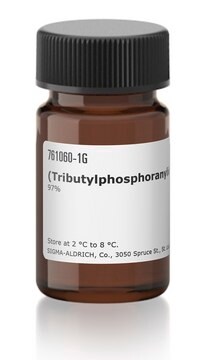255920
1,1′-(Azodicarbonyl)dipiperidine
99%
Sinónimos:
1,1′-Azobis(N,N-pentamethyleneformamide), ADD, Azodicarboxylic acid dipiperidide, NSC 356027, SR 4077
About This Item
Productos recomendados
Nivel de calidad
Ensayo
99%
Formulario
solid
mp
134-136 °C (lit.)
grupo funcional
azo
cadena SMILES
O=C(\N=N\C(=O)N1CCCCC1)N2CCCCC2
InChI
1S/C12H20N4O2/c17-11(15-7-3-1-4-8-15)13-14-12(18)16-9-5-2-6-10-16/h1-10H2/b14-13+
Clave InChI
OQJBFFCUFALWQL-BUHFOSPRSA-N
Aplicación
- Polyfluoroalkylated tripyrazolylmethane ligands
- (-)-Hygromycin A via Mitsunobu glycosylation
- Optically active α,α-disubstituted amino acids via Mitsunobu reaction
- Aza-β-lactams through [2+2] cycloaddition reactions
- Glycosyl disulfides
- Pyridine ether PPAR agonists
- S-glycosyl amino acid building blocks for combinatorial neoglycopeptide synthesis
- Histamine H3 receptor antagonists
Reactant for:
- Mitsunobu inversion reactions
Palabra de señalización
Warning
Frases de peligro
Consejos de prudencia
Clasificaciones de peligro
Eye Irrit. 2 - Skin Irrit. 2 - STOT SE 3
Órganos de actuación
Respiratory system
Código de clase de almacenamiento
11 - Combustible Solids
Clase de riesgo para el agua (WGK)
WGK 3
Punto de inflamabilidad (°F)
Not applicable
Punto de inflamabilidad (°C)
Not applicable
Equipo de protección personal
dust mask type N95 (US), Eyeshields, Gloves
Elija entre una de las versiones más recientes:
¿Ya tiene este producto?
Encuentre la documentación para los productos que ha comprado recientemente en la Biblioteca de documentos.
Los clientes también vieron
Artículos
One of the most powerful and widely used carboncarbon bond forming reactions in organic synthesis is the Mitsunobu reaction.
Nuestro equipo de científicos tiene experiencia en todas las áreas de investigación: Ciencias de la vida, Ciencia de los materiales, Síntesis química, Cromatografía, Analítica y muchas otras.
Póngase en contacto con el Servicio técnico








